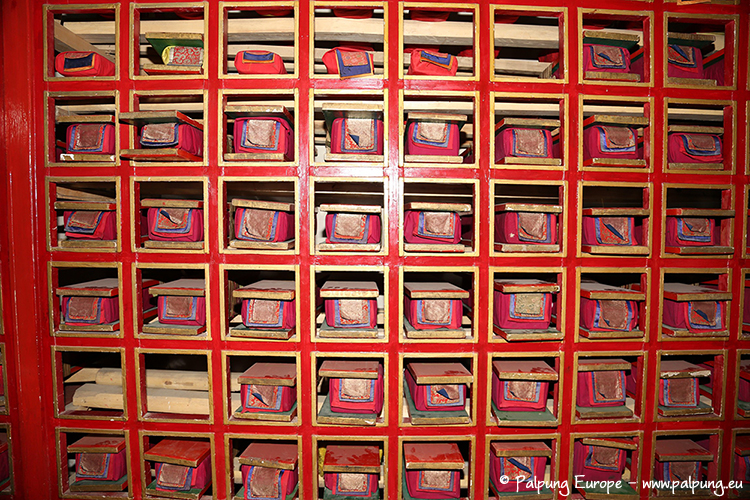The Kangyur and Tengyur
Meaning
The Kangyur are the direct teachings and words of the Buddha. The Buddha said, “During the time of degeneration, I will appear as the letters (texts).” So all of these teachings are an emanation of the Buddha and we have to see them as objects of refuge. In essence, the Kangyur is the root of our dharma, the source of our teachings, and the true guide of what to do and what not to do.
Later, the Tibetan masters wrote and taught commentaries, the treatises, the Tengyur. Their authority and sacredness derives partly from their provenance, but also to a large extent from their perceived transformative power.
History
The Kangyur was not published at first. The teacher of Chim Jampel Yang made the first collection of the Kangyur and it was handwritten. Known as the Jang Kangyur because it was kept in a shrine room called the Jam Lhakhang at Narthang Monastery, it was the first Tibetan Kangyur published in Tibet. This occurred during the time of Emperor Yung Lo of the Ming Dynasty. Butön Rinchen Drub (1290-1364) played an important role in the establishment of the Kangyur and Tengyur in its present form. He catalogised thousands of religious and philosophical texts and was involved in the compilation of the Kangyur and Tengyur. He is also the author of one of the most important works on the history of Buddhism in India and Tibet.
Editions
The most reliable version of both the Kangyur and the Tengyur is the Dege collection, printed in the 18th century at the Dege Printing House or Dege Parkhang, under the patronage of the Tenpa Tsering, (1687-1738), the 12th headman and 6th dharma-raja of Dege, ruler of the Dege Principality, and the editorship of Tai Situ Rinpoche, the Great Panchen Chökyi Jungne. A large number of new translations were added by Situ Panchen’s successor, Shuchen Tsultrim Rinchen. Shuchen’s Dege Kangyur, known as the post-Parphu, is the Dege Kangyur that is printed today. In the house are kept more than 200,000 blocks of religious, historical, literature and art, medical, astronomical and calender-arithmetical book edititons in Tibetan.
We will get our texts from Dege.
Kangyur
The Kangyur contains nine sections of 1,108 teachings by Buddha, total pages: 33,707. These sections are:
Vinaya – Cause and effect (karma), guidelines for action, 13 volumes, 3944 pages.
Prajnaparamita – Perfection of Wisdom, 21 volumes 8565 pages.
Avatamsaka – Resplendent Fields of Buddha Realms, 4 volumes 1548 pages. Ratnakuta – Wondrous Jeweled Spheres of the Buddha, 6 volumes 1757 pages.
Sutra – The Collection of Brief Essential Teachings, 32 volumes 9741 pages.
Tantra – Mantrayana Teachings, 24 volumes 5995 pages.
Pratantras – Ancient Nyingma Tantras, 3 volumes 956 pages.
Kalacakra – Wheel of Time, 2 volumes 561 pages.
Dharani – Sacred Healing Syllables, 2 volumes 469 pages.
Catalogue of Kangyur – Written by Situ Chokyi Jungne, 1 volumes 171 pages.
Tengyur
The Tengyur contains 17 sections of 3,354 commentaries by 700 scholars, total pages: 64,200.
Stotras — Praises to the Buddhas
Tantra — Tantra Commentaries
Prajnaparamita — Perfection of Wisdom
Madhyamaka — Middle Way Sutra Commentaries
Cittamatra — Mind-Only Teachings
Abhidharma — Science of Mind
Vinaya — Models for the Sangha’s Way of Life
Jataka — Life Stories of the Buddha
Lekha/Parikatha — Letters and Accounts
Please donate generously so that we may soon getthe appr. 3000 € together, with the reference “texts”, using
online donations
bank transferral (account info in the Impressum)









